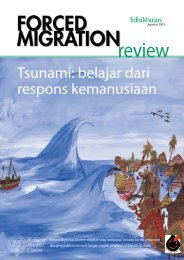FMR 42 full issue pdf - Forced Migration Review
FMR 42 full issue pdf - Forced Migration Review
FMR 42 full issue pdf - Forced Migration Review
Create successful ePaper yourself
Turn your PDF publications into a flip-book with our unique Google optimized e-Paper software.
<strong>FMR</strong> <strong>42</strong><br />
Sexual orientation and gender identity and the protection of forced migrants 35<br />
for not seeking protection”, ostensibly in order<br />
to help caseworkers build up a history of the<br />
applicant’s experiences. However, research has<br />
shown that in practice this requirement can<br />
become a barrier to successful applications,<br />
as border agents may decide someone<br />
who did not seek protection did not feel<br />
significantly threatened. While this may<br />
seem reasonable in the context of the UK, it<br />
is much less so in areas where police, other<br />
officials and even family members engage in<br />
the rape, torture or killing of trans people.<br />
For trans claims, interviewers are instructed<br />
to “explore what the applicant is claiming to<br />
be their current gender identity and establish<br />
the range of behaviour and activities of life<br />
that inform or affect the individual’s gender<br />
identity, or how they are perceived”. The<br />
phrase “current gender identity” ignores the<br />
evidence base that many if not most trans<br />
people have felt their gender/sex variance<br />
since childhood. The reference to a “range<br />
of behaviour” is troubling in its evocation<br />
of essentialised norms (women do this, men<br />
do that), and its implication that in order to<br />
be legitimately trans, one has to behave in<br />
a certain way. Further, by focusing on how<br />
they are perceived by others, the guidance<br />
belies the lived experiences of many trans<br />
people, who state they have always felt<br />
themselves to be transgender, regardless of<br />
how they are outwardly perceived. At <strong>issue</strong><br />
is the notion that in order to be transgender<br />
one must already be in transition, which<br />
is not the case. This goes against the<br />
experience of many trans people, as well as<br />
a substantial amount of trans theory that<br />
establishes gender identity as internal and<br />
disconnected from body morphology. In<br />
other words, ‘transitioning’ from one gender<br />
to another is less about ‘changing’ gender<br />
than ‘aligning’ the exterior with the interior.<br />
The GII guidance also directs decisionmakers<br />
to look for evidence of transitioning<br />
such as “some or all of the following<br />
personal, legal and medical adjustments:<br />
telling family, friends and colleagues;<br />
changing one’s name and/or sex on legal<br />
documents; dressing, behaving and/or<br />
living as a different sex; hormone therapy;<br />
and possibly surgery.” By referring to<br />
practices which are common in the UK, the<br />
guidance neglects the fact that outward<br />
transitioning is often not socially, medically<br />
and/or legally possible in the applicant’s<br />
country of origin, and as such cannot be<br />
relied on as an indicator of felt gender.<br />
Proving ‘well-founded’ fear<br />
In assessing claims, the primary role of<br />
the decision-maker is to “assess objectively<br />
whether there are reasonable grounds for<br />
believing that the applicant … would face<br />
persecution” if repatriated. The UKBA<br />
guidelines centre on whether the country<br />
of origin “takes reasonable steps to prevent<br />
the persecution or suffering” of trans<br />
people. The guidance acknowledges that<br />
while it may appear that a state which does<br />
not criminalise homosexuality or trans<br />
identity offers ‘reasonable’ protection, this<br />
is often not the case; however, there are<br />
no specific statutes about what constitute<br />
“reasonable grounds” or “reasonable<br />
steps”. Caseworkers are directed to “assess<br />
objectively whether there are reasonable<br />
grounds for believing that there would be<br />
a real risk of serious harm”, without a clear<br />
indication of what level of proof is required.<br />
The GII guidance directs decision-makers<br />
to the Country of Origin Information (COI 3 )<br />
to determine grounds for asylum. However,<br />
COI is only updated periodically and there<br />
is little or no information on lesbians and<br />
trans people in most COI reports. One of<br />
the greatest risks to transgender asylum<br />
seekers is that the lack of trans-specific<br />
discrimination information is frequently<br />
taken as an absence of threat. One senior<br />
caseworker said, “I can’t see that there would<br />
be any circumstances where persecution<br />
of gay people would not be reported … So<br />
you have to ask, if there’s no evidence that<br />
can be found anywhere, whether it actually<br />
exists at all.” 4 For some countries the COI<br />
data is misleading. For example, some states,<br />
such as Iran, allow transsexual surgery as a<br />
forced method of preventing homosexuality<br />
rather than supporting trans identities, while




